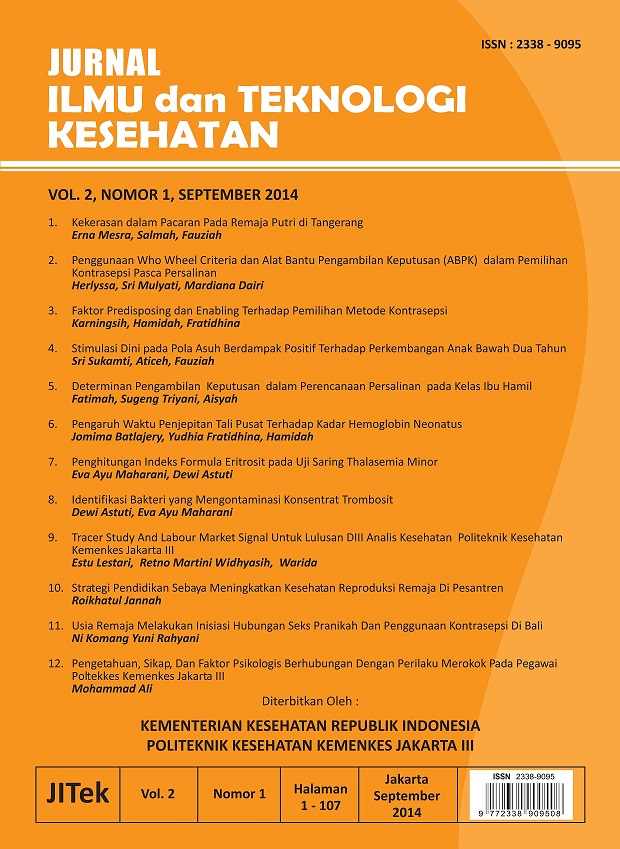Main Article Content
Abstract
Public demands into a high quality of health examination with right, accurate and appropriate are increased. Hence, it is responsibility of health professional to provide better service. However, the number of health analyst workers called laboratorian have various diverse of educational background. In respon to providing high quality analysts, Polytechnic of Health Ministry of Health Jakarta III intends to identify its graduation who work in health services in Jakarta and surrounding areas. This study aims to evaluate the progress of Program D III at Health Analyst department as well as its development; to assess the need of user about health analysts education level; and to improve the performance of Health Analyst department. The study is designed as cross-sectional with the use of descriptive research / survey type. The target of population were the entire graduated of Health Analyst department. Data collection was conducted in the area of Jakarta, Bogor, Depok, Tangerang and Bekasi (Jabodetabek) among alumni who work in hospital laboratories and 9 (nine) Clinics and Health Centers. Total number samples participated is 94 alumni. All data collected then was analyzed using SPSS. Learning experience in laboratory is the most important for alumni competence in the workplace, followed by learning experience in a community and hospital internships. It means there is association between education and the job attained. Professional certification is more important than academic achievement (IP), and participant expecting DIII program development into Bachelor level. " Tracer Study and labor Market Signal " encourage Health Analyst DIII Programme to improve Teaching Learning Process according to stakeholders needs
Smoking is harmful. Therefore, many employees in the healthcare sector keep behave as smoker. The purpose of this study was to determine the correlation between knowledge, attitudes, and psychological factors on why people smoke. This survey is a cross-sectional study among 132 male staff at the Health Polytechnic Ministry of Health Jakarta III. Data analysis used was frequency distribution for univariate analysis, chi square test for bivariate analysis, and logistic regression for multivariate analysis. The result reveals that the number of respondents those have smoking habit is 45.5%, the majority of respondents have less knowledge (72.0%), those with positive attitude is 71.2%, and the number of psychological factors influence smoking practice is 58.3%. Bivariate analysis on variable knowledge, attitude, and psychological factors result in respectively data as follow: p=0.014 and OR=3.000, p = 0.016 and OR = 2.762, and p = 0.003 OR = 3.176. The dominant factor is well knowledge (OR = 6.658). Thus, we suggest that health promotion related quitting smoke should focus on increasing knowledge about bad effects of smoking.
Keywords
Article Details
Authors who publish with this journal agree to the following terms:
1. Authors retain copyright and grant the journal right of first publication with the work simultaneously licensed under a Creative Commons Attribution-ShareAlike License that allows others to share the work with an acknowledgment of the work's authorship and initial publication in this journal.
2. Authors are able to enter into separate, additional contractual arrangements for the non-exclusive distribution of the journal's published version of the work (e.g., post it to an institutional repository or publish it in a book), with an acknowledgment of its initial publication in this journal.
3. Authors are permitted and encouraged to post their work online (e.g., in institutional repositories or on their website) prior to and during the submission process, as it can lead to productive exchanges, as well as earlier and greater citation of published work (See The Effect of Open Access).
References
-
Aditama, Tjandra Yoga. 1992. Rokok dan Kesehatan, FKM UI Press. Depok.
Alamsyah, R.M. 2009. Faktor Yang Mempengaruhi Kebiasaan Merokok dan hubungannya dengan Status Penyakit Periodontal Remaja Di Kota Medan. Tesis. Sekolah Paska Sarjana, Universitas Sumatera Utara Medan.
Anthenelli, R.M., Morris, C., & Ramey, T.S. 2013. Effects of Varenicline on Smoking Cessation in Adults With Stably Treated Current or Past Major Depression: A Randomized Trial.Annals of Internal Medicine 2013;159(6): 390-400
Aryani, M. 2010. Hubungan Antara Sikap Terhadap Kesehatan dengan Perilaku Merokok. Diakses dari download.portalgaruda.org/article.php? article...val.pada tanggal 19 Desember 2014.
Isomura, S. Et.al. 2001. An Immunotherapeutic Program for Treatment of Nicotine Addiction. American Chemical Society .J. Org. Chem., 2001, 66 (12), pp 4115- 4121
Green, W. L. 1980. Health Education Planning. A Diagnostic Approach. Palo Arto. California : Mafield Publising Company.
Hasnida & Kemala, I. (2005). Hubungan antara Stres dan Perilaku Merokok pada Remaja Laki-laki. Fakultas Kedokteran Universitas Sumatera Utara. Diakses dari repository.usu.ac.id/.../1/psi-des2005- %20(7), pada tanggal 20 Desember 2014.
Kemenkes, RI. 2013. Laporan Riskesdas 2013. Diakses dari www.litbang. depkes.go.id/sites/.../rkd2013.pada tanggal 18 Desember 2014.
Komalasari, D & Helmi, A.F. 2000. FaktorFaktor Penyebab Perilaku Pada Remaja. Diakses dari Avin.staff.ugm.ac.id/ data/jurnal/perilaku merokok avin.pdf. pada tanggal 18 Desember 2014.
Notoatmojo (2007).Pendidikan dan perilaku kesehatan.Jakarta : Reneka Cipta.
Salawati, T., & Amalia, R. 2010. Perilaku Merokok Di Kalangan Mahasiswa Universitas Muhammadiyah Semarang. Diakses dari download.portalgaruda.org/ article.php?article...val. pada tanggal 19 Desember 2014
Sarwono, S.W. 2000. Teori-teori Psikolologi Sosial. Jakarta : Raja Grafindo Persada.
Smet, B. 1994. Psikologi Kesehatan. Jakarta: Grasindo.
Sudarmiyati & Nunuk. 2011. Perbedaan Tingkat Motivasi Berhenti Merokok Antara Tenaga Kesehatan Dan Tenaga Non Kesehatan Di Rumah Sakit Umum Daerah Sangatta Kabupaten Kutai Timur Kalimantan Timur. Tugas Akhir, Jurusan Ilmu Keperawatan Fakultas Kedokteran Universitas Brawijaya.
Sugito, 2007. Stop Merokok. Mudah, Murah, Cepat. Cetakan I. Semarang : Penebar Swadaya.
Wismanto, Y.B., & Sarwo, Y.B. 2007. Strategi Penghentian Perilaku Merokok. Unika Soegijapranata, Semarang.
